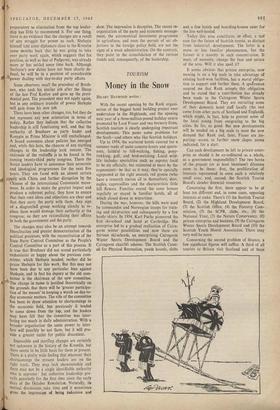TOURISM
Money in the Snow
HILARY HAYWOOD writes :
With the recent opening by the Rank organi- sation of the biggest hotel building project ever undertaken in the Highlands, and the opening next year of a three-million-pound holiday centre promoted by Lord Fraser and two brewery firms, Scottish tourism is clearly undergoing important developments. This poses some problems for the Scots—and others who like Scottish holidays.
Up to 1954, the scattered hotels catered for a summer trade of quiet country-lovers and sports- men, faithful to hill-walking, fishing, pony- trekking, golf, and bird-watching. Local wild- life includes specialities such as ospreys (said to be six officially, but estimated at more by the cognoscenti—be that as it may, they're specially signposted at the right season), red grouse (who have a research station all to themselves), deer, eagles, capercaillies and the characteristic little hill flowers. Families rented the same houses regularly or stayed in familiar hotels, all of which closed down in wintertime.
During the war, however, the hills were used by commandos and Norwegian troops for train- ing and ski-practice and subsequently by a few hardy skiers. In 1954, Karl Fuchs pioneered the first ski-school and hotel at Carrbridge. His enterprise led to a gradual realisation of Cairn- gorm winter possibilities and now there are thirteen ski-schools, an enterprising Cairngorm Winter Sports Development Board and the Cairngorm chairlift scheme. The Scottish Coun- cil for Physical Recreation, youth hostels, clubs and a few hotels and boarding-houses cater for the less well-heeled.
Today this area constitutes, in effect, a test case for the future of Scottish tourist, as distinct from industrial, development. The latter is a more or less familiar phenomenon, but the former is a novelty in such concentration. It must, of necessity, change the face and nature of the area. Will it also spoil it?
It seems obvious that private enterprise, now moving in on a big scale to take advantage of existing hard-won facilities, has a moral obliga- tion to support and further these. A spokesman assured me that Rank accepts this obligation and he stated that a contribution has already been made to the Cairngorm Winter Sports Development Board. They are recruiting some of their domestic hotel staff locally (the rest come from other parts of Scotland and England), which might, in fact, help to prevent some of the local young from emigrating to the big cities. So far, so good. But new developments will be needed on a big scale to meet the new demand that Rank and, later, Fraser are im- porting—access to further snow slopes seems indicated, for a start.
Can such development be left to private enter- prise or should it be co-ordinated as a whole, as a government responsibility? The two horns of the present (or at least imminent) dilemma seem to be these: first, the proliferation of interests represented in even such a relatively small area; and, second, the Scottish Tourist Board's slender financial resources.
Concerning the first, there appear to be at least ten different and, in some cases, opposing interests at stake. There's (1) the Scottish Tourist Board, (2) the Highland Development Board, (3) the Scottish Office, (4) the Forestry Com- mission, (5) the SCPR, clubs, etc., (6) the National Trust, (7) the Nature Conservancy, (8) private enterprise and business, (9) the Cairngorm Winter Sports Development Board and (10) the Scottish Youth Hostel Association. There may very well be more.
Concerning the second problem of finance, a few significant figures will suffice. A third of all tourists to Britain visit Scotland and of these 50 per cent are from the US. Northern Ireland receives an annual government tourist grant of £200,000; the Isle of Man gets £150,000; Eire spends an annual £24 million on tourism; Scotland has just received a grant of £25,000 a year for the next three years for research into her tourism industry. One would have thought that fully-financed action would be more to the point than shoestring research, particu- larly as the government grant to Rank's Coylum- bridge hotel alone must be around £175,000.
Thus it appears that private enterprise will be the main developer of some of Britain's loveliest natural scenery, for the next three years at any rate. It may be that tact, imagination and co- ordinated planning will be brought to the task : this is a chance for big businessmen to demon- strate that they are not inevitably barbarians. In the meantime, now is the time to see it all as it was—peaceful and rare.































 Previous page
Previous page